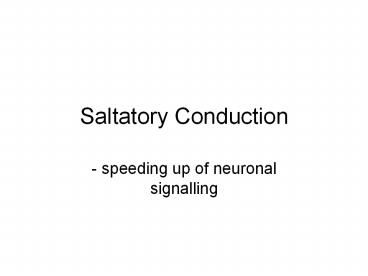Saltatory Conduction - PowerPoint PPT Presentation
1 / 31
Title:
Saltatory Conduction
Description:
Saltatory Conduction - speeding up of neuronal signalling Exposed areas on neuron with many voltage-gated sodium channels, able to depolarize and pass on signal ... – PowerPoint PPT presentation
Number of Views:1488
Avg rating:3.0/5.0
Title: Saltatory Conduction
1
Saltatory Conduction
- - speeding up of neuronal signalling
2
Myelin
- an insulating layer
- made of Schwann cells
- protective
- speeds signal transmission in myelinated neurons
action potentials only happen at the nodes of
Ranvier
3
- Exposed areas on neuron with many voltage-gated
sodium channels, able to depolarize and pass on
signal - Action potential jumps from node to node,
causing voltage-gated Na channels to open
4
Figure 2.20 Saltatory conduction in a myelinated
axonAn action potential at the node triggers
flow of current to the next node, where the
membrane regenerates the action potential.
5
- Results in nerve impulse
- Passing on of signal down the neuron
- Much faster in myelinated neurons (120 m/s) than
in non-myelinated (0.5 m/s)
6
(No Transcript)
7
(No Transcript)
8
(No Transcript)
9
The Synapse
- The synapse is the junction between neurons
- Synapses are found between sensory receptors and
sensory neurons and between motor neurons and
muscle cells (effectors) - The transmitting cell is called the presynaptic
cell and the receiving cell is the postsynaptic
cell - There are two main types of synapses
- 1) electrical synapses
- 2) chemical synapses
10
a) Electrical Synapse
- Pre and post synaptic cells are connected by gap
junctions that allow action potentials to pass
directly from one cell to another
11
b) Chemical Synapse
12
(No Transcript)
13
(No Transcript)
14
- The electrical signal is converted into a
chemical signal, and then back to an electrical
signal in the post cell - Within the cytoplasm of the presynaptic cell
there are numerous sacs filled with
neurotransmitters, the messenger molecules that
will be released into the synaptic cleft, as a
result of an action potential - The neurotransmitters will bind to receptors on
the postsynaptic neuron, causing its
depolarization (action potential) - Neurotrasmitters in cleft are degraded by enzymes
or taken up by neurons for re-use
15
Chemical Synapse
16
(No Transcript)
17
Neurotransmitters
- 1) Dopamine and serotonin (amines)
- Technically the only two things you enjoy!
- Mood regulators, linked to sensations of pleasure
- Dopamine has been linked to schizophrenia and
Parkinsons disease. - Not enough serotonin is linked to depression
- Serotonin and LSD (hallucinogen) have similar
structures
18
(No Transcript)
19
- Endorphins (peptides, endogenous morphines)
- Natural painkillers, affect emotions
- Released during exercise runners high
- Similar to opiates, morphine and heroin bind to
the same receptors
20
- Norepinephrine (amine)
- Complements the actions of epinephrine, readies
the body to respond to danger/stress
21
- OK, but why do some things feel kind of good and
others REALLY good?
22
- The All-or-None Law
- The size, amplitude, and velocity of an action
potential are independent of the intensity of the
stimulus that initiated it. - How then is stimulus intensity coded?
23
Summation
- The figure below shows a typical neural pathway
- When neuron A and Neuron B fire together an
action potential is triggered in neuron D - Note that neuron C is inhibitory
24
Temporal and Spatial Summation
25
(No Transcript)
26
Peripheral Nervous System
27
- divided into two parts
- Somatic System
- controls voluntary movement of skeletal muscles
- myelinated
28
2. Autonomic System
- controls involuntary glandular secretions and
functions of smooth and cardiac muscle - divided into
29
i. sympathetic nervous system
- activates fight or flight response
- norepinephrine (neurotransmitter) works with
epinephrine (hormone) to activate stress response - blood pressure increases (vasoconstriction),
heart beats faster, digestion slows down, etc. - released by modern stressors anxiety
30
ii. parasympathetic nervous system
- involuntary control in opposition to the
sympathetic nervous system - activated when the body is calm and at rest (ex.
meditation) - the break to sympathetic NSs gas pedal
31
(No Transcript)
32
HOMEOSTASIS!!!!































